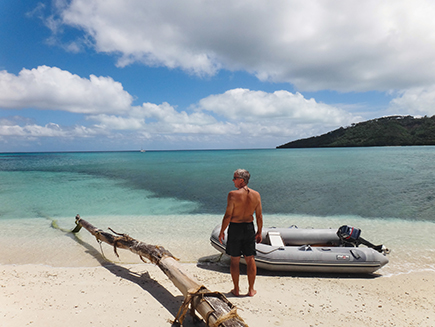A voyage through Papua New Guinea reveals the friendly side of these rarely cruised islands (published December 2014)
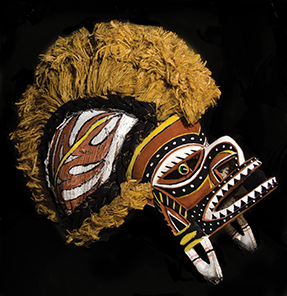
Where to next? Jim and I had been in Australia for six months and were ready to move on. Most voyagers go north to Darwin, join a rally to sail through the red tape of Indonesia, and continue on to Malaysia, Singapore and Thailand. From there, they can cross to South Africa or ship their boats into the Mediterranean. The Somali pirate situation is too dangerous to consider sailing through the Red Sea.
Although we enjoy the company of other cruisers, exploring new places with dozens of others only to see “local life” staged for our benefit does not appeal to us. We were not sure how we would proceed until friends suggest sailing through the remote islands of Papua New Guinea. Although PNG has a reputation for violence, they assured us these stops would be safe.
MYSTERIOUS YET FRIENDLY PNG
Papua New Guinea. The name conjures up images of fierce warriors dressed in paint, leaves and shells, wielding dangerous projectiles and living in huts deep in the jungle. Reality, I imagined, is quite different. But what would the people be like on these isolated islands? What would we learn there?
It is a boisterous five day, 682 mile passage from Cairns, Australia to the Louisiade Archipelago, 120 miles southeast of mainland Papua New Guinea. I never find my sea legs so I am thrilled when we clear the uncharted pass through the reef at Panasia and slip into serenity. “Pana” means “island” in the local language, “sia” means “rock”. It describes the island well. Limestone peaks tower above the shimmering lagoon while dense bush clings to all but the steepest walls. Palm trees shade the sandy beach in the crook that forms the protected anchorage.
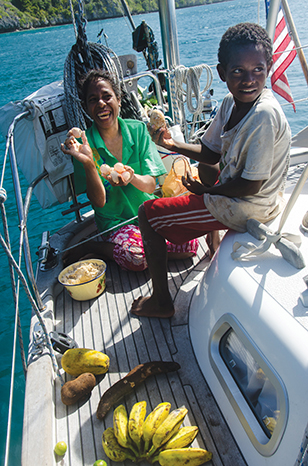
As the anchor sets, a man appears on the beach and waves. We go ashore and meet John, Gwen and their family. John says to stay as long as we’d like and sends us back to Tenaya with four lobster tails. The next day a steady stream of visitors arrives by sailing canoe; most come from Brooker Island ten miles across the lagoon. A sailboat means trading opportunities and a marvelous cornucopia is loaded onto our deck: delicious pawpaw (papaya), sweet bananas, yams, potatoes, pumpkins, green coconuts, limes, eggs, baskets, clay pots and beautiful shells. How do they transport fresh eggs on a leaking, bouncing sailing canoe? In a bowl of sand!
To my surprise, Linda digs out six chicken eggs and one bush fowl egg. She is amazed I do not know this trick. Clothing tops the list of requests and our bags from St. Vinnies are soon gone. Why the early missionaries convinced people living in an ideal climate to wear modest western apparel is beyond me. There are no stores here and it doesn’t appear modern missionaries make regular clothing drops.
Sailing canoes are called “sailaus” in the local Misima language. They are made by master craftsmen on Panaeti and Panapompom Islands further north. Keen to learn more about them, we sail 31 miles to Panapompom in slight seas and 11 to 17 knots of southeast wind.
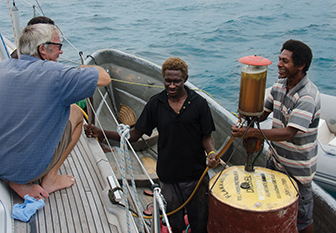
Bommies are clearly visible nine meters below as we approach the anchoring waypoint between Nivani and Panapompom Islands. A man in a dugout canoe intercepts and guides us to a spot he insists will protect us from the prevailing southeast winds. Once the anchor is set, Martin comes aboard to share banana bread and stories. People in PNG love to tell stories.
Milia instilled the idea of locals respecting visitors and their boats. His rules—do not steal things, offer to trade if you want something, do not ask for too much, do not let your canoe touch the sailboats and be polite. One of his sons, Ishmael, is the new Ward Councilor. He is kind, soft-spoken and eager to liaise with the government to help the people of Panapompom. Julie Tobby is the head teacher at the elementary school. She wishes there was enough money for each child to have a simple desk to keep their notebooks off the dirt floor.
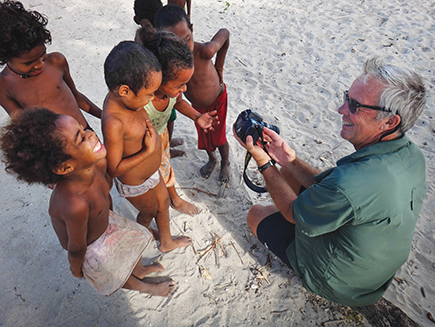
“Are there crocodiles here?” Jim asks Tobby, Milia’s son and Julie’s father. “No, the boys shoot them.”
But if there were crocs here, they would live in the river that must be crossed to reach the school. So when Roseanne’s dog bounds into the water and emerges on the other side unscathed I am pleased. It’s hard to believe six to 10 year old children make this hour-long trek through the forest twice each day. As we near the three school buildings built of bush material, we hear excited voices repeating, “Dim Dim!” That’s pidgin for white people. Dozens of kids scurry about as Julie gives us a tour. We are impressed by her dedication and competence, and to see phonics written on a large chalkboard and arithmetic on another. Education is important on Panapompom and the kids are already learning English.
Money, called “kina”, is hard to come by. In the past people produced copra but now the prices are very low. Men collected “beche-de-mer”, sea cucumbers, but that is banned for the foreseeable future to counteract overharvesting. Because they need kina to pay school fees, parents sell intricately carved wooden spears, detailed model “sailaus”, lovely baskets and treasures from the sea to the few voyagers that pass through.
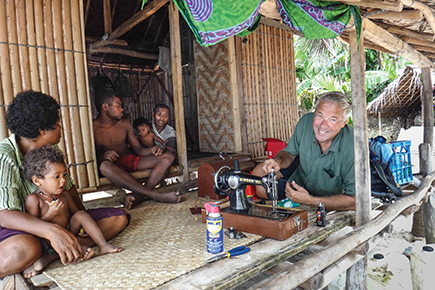
Jim tells Martin that he repaired two sewing machines on Panasia. It turns out Martin has a broken Singer hand crank too. Jim takes his tools in and together they fix it. Martin had worked as an equipment repairman when the mine was operating on Misima. He’s sharp. And his ancient machine was well oiled. Over the course of our stay Jim repairs several more sewing machines, a water tank and provides the parts to repair a sailau. People know how to fix things but lack the supplies to do so.
MOVING NORTH
It is a five day, 664 mile passage north from Panapompom to Kavieng at the tip of New Ireland. We could stop at Budibudi Atoll, which has a safe anchorage and welcoming people, but we keep going. For safety reasons we pass by Kokopo and check-in at Kavieng. The plan is to refuel, restock and be on our way in a few days. We stay three weeks. The anchorage is calm, Wi-Fi is available, people are friendly, diving is spectacular and there is a bar and restaurant at the eco-resort ashore.
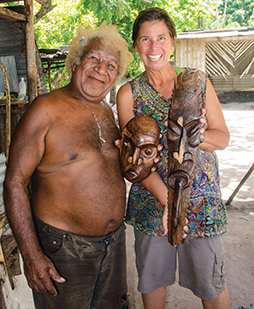
Dorothy works in the kitchen. Her father carves the evocative masks displayed in the thatched-roofed, dirt-floored, open-air restaurant. Bruno Mondo is classic! His quick wit and quirky art are captivating. When he offers to whittle a face with a long tongue especially for us, I am delighted and give him a big hug. On the way back from Panakondo village we walk along the shore introducing ourselves to those we meet. Our story goes something like this: “Hello, we are Jim and Katie from the yacht. We are Americans but sailed from Europe. The yacht is our home. We live on it all the time. For seven years now. Thank you for letting us park our home in your bay.”
They ask questions about us, we ask questions about them. We invite them to visit and are surprised to hear we are the first to do so. They assure us that Tenaya is safe. No harm will come to her.
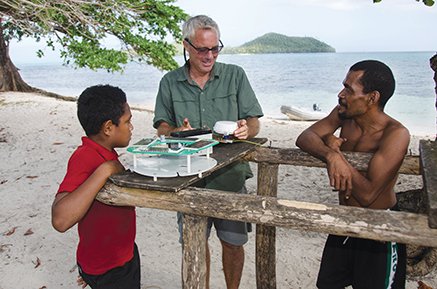
Even in town, people are nice. Many say hello before we do. When Jim asks about buying 300 liters of diesel, Malcolm says he will find a boat and bring out a 200 liter drum with a pump and cans holding the remaining fuel. He doesn’t trust Jim with his precious pump. He comes the next morning and is happy to be invited aboard for a cold Coke. He has never seen the inside of a sailboat before.
Dorothy’s husband offers betel nut to Jim. He forgets to tell my adventurous husband to keep the mustard seed, which is dipped in lime (the mineral, not the fruit), away from his tongue and to only poke it into the pulp wedged into his cheek. Jim’s tongue hurts the rest of the night but it is red, like the locals’, and he is happy. Each time we part company with our new friends we say, “Mi lukin yu behaen,” “I’ll see you later’ in pidgin.” When we leave for last time Jayne says, “Mi lukin yu no mo.” Tears roll down my cheeks.
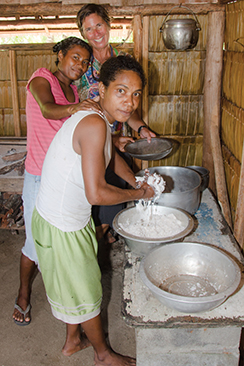
THE HERMITS
There is no wind during our three day trip west to the Hermit Islands. They are surrounded by a barrier reef and the island of Luf, our destination, is wrapped in its own reef. It is shaped like a barbell with bays on both sides of the narrow bar. The village is built along this low section while hills burst with palm trees and thick foliage at each end. We hope for good light but dark clouds roll in as we enter the lagoon. Thunder rumbles in the distance.
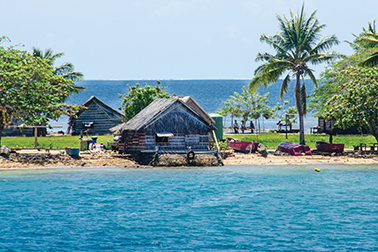
We head for Carola Bay, on the south side, and choose the beefiest looking mooring. It is very close to a reef. No sooner have we strung our lines through than a squall hits and blows over 25 knots. I hunker down at the bow in pelting rain watching our position to shore to be sure we don’t blow down on the reef.
The next morning two young women in a leaking canoe paddle out to greet us. Lorraine teaches sixth grade and Baxter runs the dispensary. We ask about buying diesel and they say Matthew will be leaving shortly for Manus Island and will be back in two days. He’ll take our jugs. We passed Manus but did not stop because it is not a safe place for cruisers. People give us delicious “pawpaw”, mangos, pineapples, bananas and oranges and ask for basic food items in return. We accept only what we can eat because big rats recently escaped from a Malaysian fishing boat and are ravaging the gardens.
I tell Baxter and Lorraine about my failed attempt to bake cassava. It is usually cooked in the ground with hot stones but a friend in Vanuatu said I could use my oven. It was a disaster. In Tenaya’s galley, I learn the secret is to spoon plenty of coconut milk over the top of the grated cassava to keep it moist. I show them how to bake banana bread. We have fun together and share a tasty lunch.
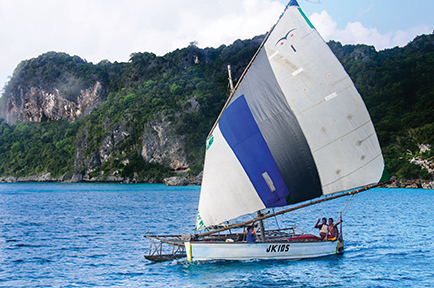
A FINAL STOP, AND MORE CANOES
Jim and I do the 60 miles to Ninigo Atoll as an overnighter to clear the outer reefs of each island group in daylight. No sooner has the anchor set than Thomas and several others zip up in a fiberglass boat with four drinking nuts to welcome us. Joseph glides by in his sailing canoe and waves. Speaking softly and looking into our eyes, Thomas says that Mal Island is a safe place. The people may offer to give us things but we are not to perceive that as trading. We are 150 miles north of the mainland. It is October and we are the fourth sailboat to visit this year—good thing they aren’t looking for trading opportunities. In the end we give our new friends several useful things.
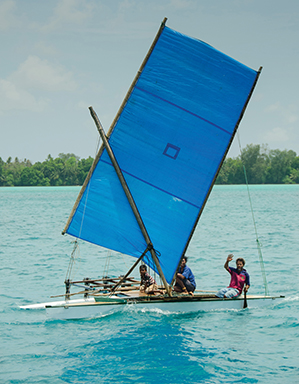
A sailing canoe is called a “wa” in the Seimat language of Ninigo. They are different than those in the Louisiades. These sails are rectangular and the platforms are less intricately constructed but more finely finished. Thomas says he is making a new one and invites us to watch while he puts the hull on the keel. We take hundreds of photos while asking nearly as many questions.
There are two kinds of coconut oil—fresh and overnight. Fresh is better as the coconut is scraped and cooked at once. In addition to cooking with it, coconut oil can be used to heal wounds. Mollina and Paulyn teach me to make it. We squeeze milk out of handfuls of coconut shavings over a strainer into a big pot. The pot goes on the fire and the milk boils. Eventually oil forms. It boils until the clear oil separates from the “poss.” Poss can be used like butter and is a rich snack on its own.
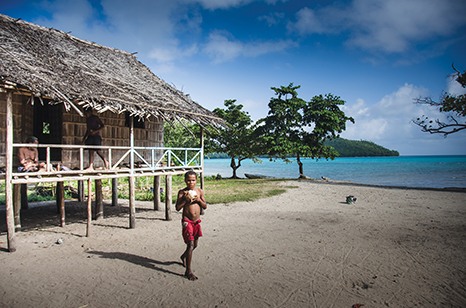
Our journey from one end of Papua New Guinea to the other lasts nearly three months. We see no other sailboats the entire time. For Jim and me, our sailing life is not simply about seeing new places and spending time with cruising friends. It is about weaving ourselves into the local tapestry, learning from those living in places we visit and sharing our knowledge and resources with them. Our floating home is a veritable workshop full of tools, bits and parts. We have skills and can offer things not usually available on remote islands. In return, we receive unconditional friendships, handmade treasures, enlightened perspectives and a bounty of sustenance. Traveling off the beaten path allows us greater opportunities to interact with the locals. Okay, where to next?
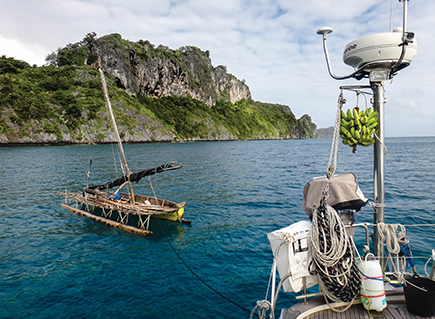
Jim and Katie Thomsen received the Ocean Cruising Club’s Rambler Medal for 2012 in recognition both of their cruising among the islands of Vanuatu and their positive actions once ashore. As they sail west, they continue to delve deeply into the waters and cultures they visit. Katie chronicles their adventures at www.tenayatravels.com.















